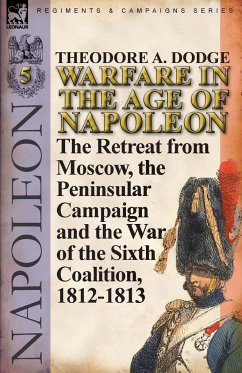
Warfare in the Age of Napoleon-Volume 6
The South of France Campaign, the Campaign of 1814 and the Campaign to the Battle of Waterloo 1813-1815
Versandkostenfrei!
Versandfertig in über 4 Wochen
40,99 €
inkl. MwSt.

PAYBACK Punkte
20 °P sammeln!
The final volume of a major work on warfare in the Napoleonic age The author of this substantial multi-volume history, Theodore A Dodge, was not only an historian of stature and note but also a soldier. He wrote several well regarded histories of the campaigns and battles of the Civil War and other works of military history. Perhaps his most outstanding achievement was a series of books, published under the umbrella title 'the Art of War,' focusing on different historical periods as typified by their most notable military commanders-including the campaigns of Alexander, Hannibal and Caesar in ...
The final volume of a major work on warfare in the Napoleonic age The author of this substantial multi-volume history, Theodore A Dodge, was not only an historian of stature and note but also a soldier. He wrote several well regarded histories of the campaigns and battles of the Civil War and other works of military history. Perhaps his most outstanding achievement was a series of books, published under the umbrella title 'the Art of War,' focusing on different historical periods as typified by their most notable military commanders-including the campaigns of Alexander, Hannibal and Caesar in the ancient world and the wars of the 17th and 18th century as fought by great captains including Gustavus Adolphus, Frederick and Marlborough. This volume is part of his in depth study of the Napoleonic period, which in its entirety was comprised of four huge volumes that benefited from the inclusion of almost 800 small scale uniform drawings, portraits of notable personalities and numerous theatre, campaign and battlefield maps. This retitled Leonaur edition has been revised to form volumes of approximately equal size reformatted to enable us to enlarge all the illustrations and maps for the benefit of the reader. This series is an excellent history of the campaigns and battles of the Napoleonic Age but it goes far beyond the historical record. Dodge critically examines the strategies and tactics of all the military commanders in such a clear and authoritative manner that the student of military history can clearly understand the errors of those about to suffer defeat and the expertise-or in the case of Napoleon Bonaparte, the military genius-of the victors. This is an invaluable guide to warfare in the age of Napoleon and is highly recommended. This final volume of Dodge's brilliant account of the 'art of war' in the Napoleonic Age concludes with the period to the end of the First Empire when the fortunes of the imperial allies turned in their favour and Napoleon and his forces, weakened by reverses, were unable to contain them. Napoleon's brilliance in the campaigns of 1814 showed that he was still an incomparable grand commander on the field of battle, especially in engagements when the odds were against him. The war had turned to one of attrition so the Empire fell, the emperor abdicated, the Bourbon monarchy was restored and Europe breathed a collective sigh of relief. But it was not quite the end-Napoleon's last great gamble for a return to power, 'The Hundred Days' and the Campaign of 1815 culminating in the great battle of Waterloo on June 18th 1815, brought the most significant commanders of both sides to a field of conflict for the first and last time. Leonaur editions are newly typeset and are not facsimiles; each title is available in softcover and hardback with dustjacket.












